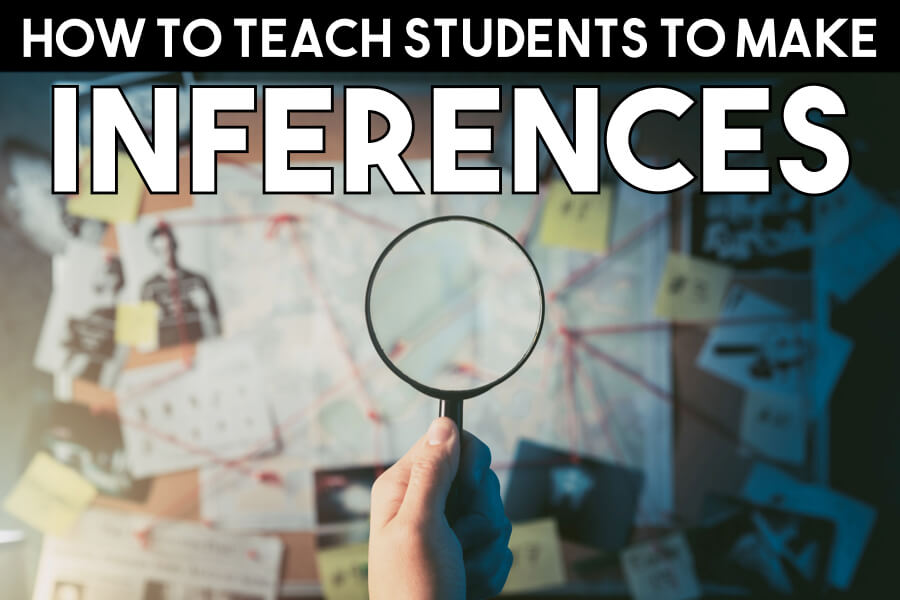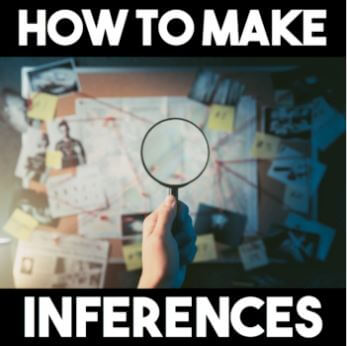Making inferences is an essential 21st century skill for the ELA classroom and beyond. From reading between the lines to activating prior knowledge, teaching students how to make inferences can be a challenge. This post is filled with tips and tricks to help.
Are you pulling your hair out as you look for a better way to teach students to make inferences on their own?
I know it’s easy to jump to the conclusion that students just don’t want to do the work. But what if there is a bigger issue at play? What if they don’t know how to do the work?
Even at the secondary level, students struggle when it comes to making inferences. But that doesn’t mean they’re lazy or don’t want to do it. Perhaps they just need a little bit of explicit instruction to pave the way for success. If you’re wondering how to teach students to make inferences on their own, this post can help.
The Importance of Teaching Students to Make Inferences
Inferencing is an imperative skill that deepens students’ understanding of a text. In order to do so, students must activate their prior knowledge, finding clues within the text, and read between the lines.
Not only do inferences help students deepen their understanding of a text, but it also lays the foundation for other reading skills too. Once students can successfully make inferences, they can also determine characterization, understand cause and effect, draw conclusions, and more.
However, the importance of teaching students to make inferences goes far beyond the walls of your ELA classroom. Not only does it lay the foundation for higher-level thinking skills, but it’s a fundamental reading strategy for deeper comprehension of a text and the world around us. Being able to draw conclusions and infer based on the clues around us is an important life skill. It’s a skill that can help us better understand people and situations. It helps us form options and beliefs. By teaching your students how to make inferences, you’ll be setting them up for success beyond any piece of text.
The Struggle With Teaching Inferences
You’re asking your students to come up with ideas or draw conclusions that aren’t right there in the text. Talk about pressure! Students thrive when they have confidence. (How many times have your students made the argument they liked math because there is a right and wrong answer?) The mere idea of making inferences can be intimidating to many students. Our job as teachers is to make it as explicit as we can. We must give them the steps and strategies they need to make inferences with confidence.
How to Teach Students to Make Inferences
While inference might come as second nature to us teachers, our students need explicit instruction to understand how to make inferences on their own. The following steps and tips can help.
My First Tip? Introduce the Idea Before Introducing the Terminology.
New terminology alone can spin students into a panic. That’s why I recommend introducing certain ideas, like inferencing, before dropping a new term in my classroom. Students become comfortable with the concept without feeling overwhelmed by the idea of learning something new. Some might call it tricking them into learning, but I call it showing them they’re capable and building confidence.
Here’s what I do:
Here’s an example for a character-related inference as you read.
Begin by saying, “The book doesn’t explicitly tell us why [INSERT CHARACTER’S NAME HERE] did/said that. But, based on what we do know, does anyone have any guesses?”
Give students a moment to finger through the text and think. Once you have a volunteer or two share their responses, be sure to follow up with, “Why do you think that?”
You can really push students to find a specific moment in the text that supports their ‘guess,’ but, at this phase, a reasonable explanation tied to the text would do.
Finally, I end by leading them to the new terminology by emphasizing, “You just used what you knew about the text to fill in the blanks about what you didn’t know explicitly. That educated guess is what we call an inference.”
I like to take it one step further by writing out the following equation on the board for students to note down:
Textual Evidence + Background Knowledge = Inference
Now that you have laid the foundation for your students, you can dig a little deeper and dive into the world of inferences.
Up Next: Explain What Inferencing Isn’t.
Making Inferences vs. Making Predictions
Do they use similar skills? Absolutely. But they aren’t the same. To squash this mix-up, remind students that predictions might rely on background knowledge, clues in the text, and inferences themselves to predict a future outcome. An inference, on the other hand, uses background knowledge and textual clues to read between the lines. Inferences are used to draw conclusions about a character or text. An inference deepens the overall understanding and, therefore, meaning of a text.
Making Inferences vs. Stating The Obvious
Another area of confusion? Stating the obvious. Remember, inferencing involves reading between the lines and activating prior knowledge. It is not stating the obvious. I love to use the barking dog as an example. If your dog was barking, stating the obvious would mean pointing out that the dog is barking. (Duh.)
However, if you recall that the dog usually barks when the Amazon delivery person drops off packages, you might assume (read: infer) that someone is at the door. Hey, you might even get excited that the package you’ve been waiting for has arrived. That’s an inference. You are drawing conclusions based on what you do know. The dark always barks when someone is at the door. Therefore, someone must be at the door now. I know this is a basic example, but starting with the basics when thinking how to teach students to make inferences is quite helpful.
Ready to Move On? Explain What Inferencing Is and How to Do It.
Return to the definition of inferencing in equation form: Textual Evidence + Background Knowledge = Inference. To ensure students understand what goes into making an inference, take time to define each part of the equation. Consider asking questions like:
- What is textual evidence?
- How have you used it in the past?
- How can we use it to support our ideas and thoughts about a text?
- What is background knowledge?
- How can we use it to understand a text better?
- How can we use it to understand the world around us better?
Then, walk students through the process of making an inference with these four steps:
It can be easy to forget our students need explicit instruction to show them how to think about a text. Only then can they successfully make inferences. Sometimes students get caught up in the task of making an inference that they do that first. They come up with their idea and then find supporting evidence. The problem? It’s a totally backward approach. You need information before you can make an inference. These steps can help:
- First, read the text. If there are specific questions to answer or a writing prompt to respond to, read that too. Remind students they are reading with a purpose, meaning they should be active readers on the lookout for important details.
- Then, take note of any relevant details. I like to provide students with graphic organizers to help them keep track of their thoughts, but traditional notes or using Sticky Notes will work too. These can be details that relate to a specific question or prompt, or ones that simply “feel” important. Students might not know why or even if they are important until a little later. That’s okay.
- Next, review the notes and look for patterns or relationships that stand out. For example, are there certain details that continue to show up? How did character X respond to situation Y? Are there any changes in a character’s behavior? Is there a cause and effect?
- Finally, put those details together to read between the lines. I like to tell my students that making an inference is like making an educated guess about someone or something based on what you do know. It’s easier to make inference when there are supporting details or background knowledge. Otherwise, they’re just shooting from the hip.
Once students know how to make inferences, they’ll be doing it left and right.
More Tips To Help Teach Students to Make Inferences
- Model The Process.
Oftentimes telling students how isn’t quite enough. We need to show them how. Choose your mentor text (a brief story or excerpt will do) and give students an all-access pass to your process. Stop and ask questions. Jot down details. Walk students through your thought process from taking notes to making observations and, lastly, making inferences.
- Begin with a Simple Text.
As teachers, we’re constantly reminded of our need to provide “rigorous” work, but don’t let that pressure put your students at a disadvantage. Begin with a simple text so students can focus on the process and skill. By the time you introduce them to a more complex text, they will have the tools, processes, and confidence they need to make an inference. The confidence? That’s huge in helping students thrive.
- Use Graph Organizers.
Graphic organizers help students keep track of their thoughts while also guiding them through the process needed to make an inference. There are tons of graphic organizers out there ranging in amount of scaffolding. Choose the one that is most suitable for your students.
- Provide Thinking Stems.
Sometimes students need a little nudge to jumpstart their thinking. That’s where thinking stems come in handy. You can include these thinking stems on a bookmark, provide an informative handout, or engage students with a worksheet. Consider these thinking stems:
- The story said … which made me think …
- I think the character feels … because …
- When the character … it made me realize …
- When … happened it might mean that …
- Based on … I think …
- I can infer … because …
I know it can save time and energy to simply reveal the answers and give student what they need to understand a text. (Guilty!) However, when we push our students to engage in more critical thought, they learn to push themselves to do so too. In turn, they gain a deeper understanding of a text and the world around them. And isn’t that what this job is all about? Helping students learn, grow, and be able to tackle the world beyond the school walls.

